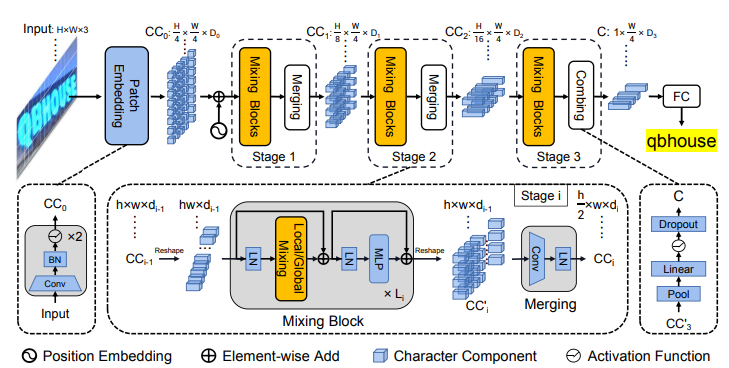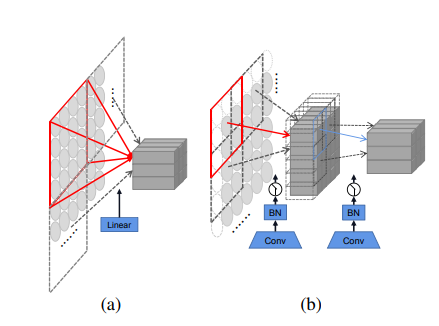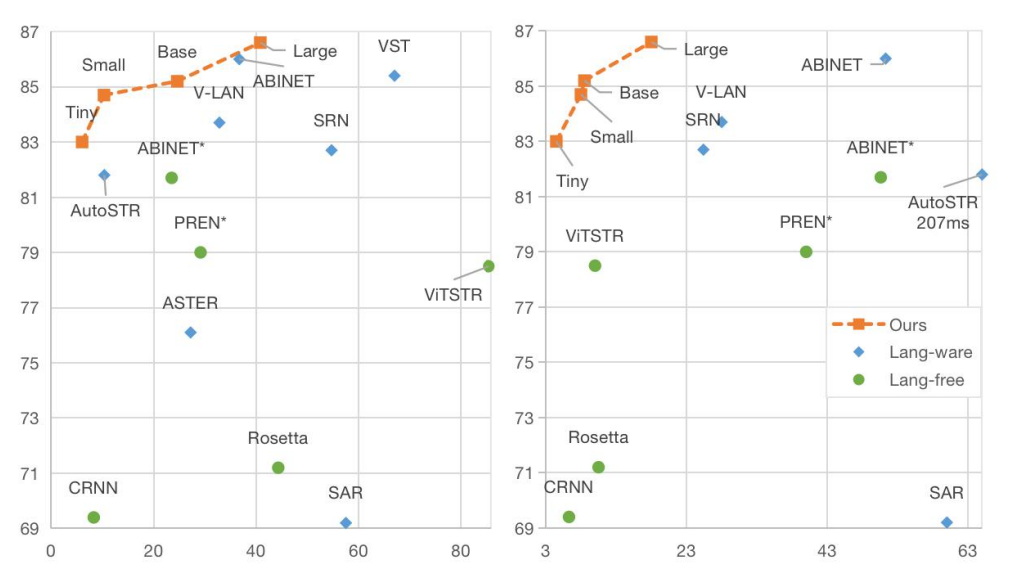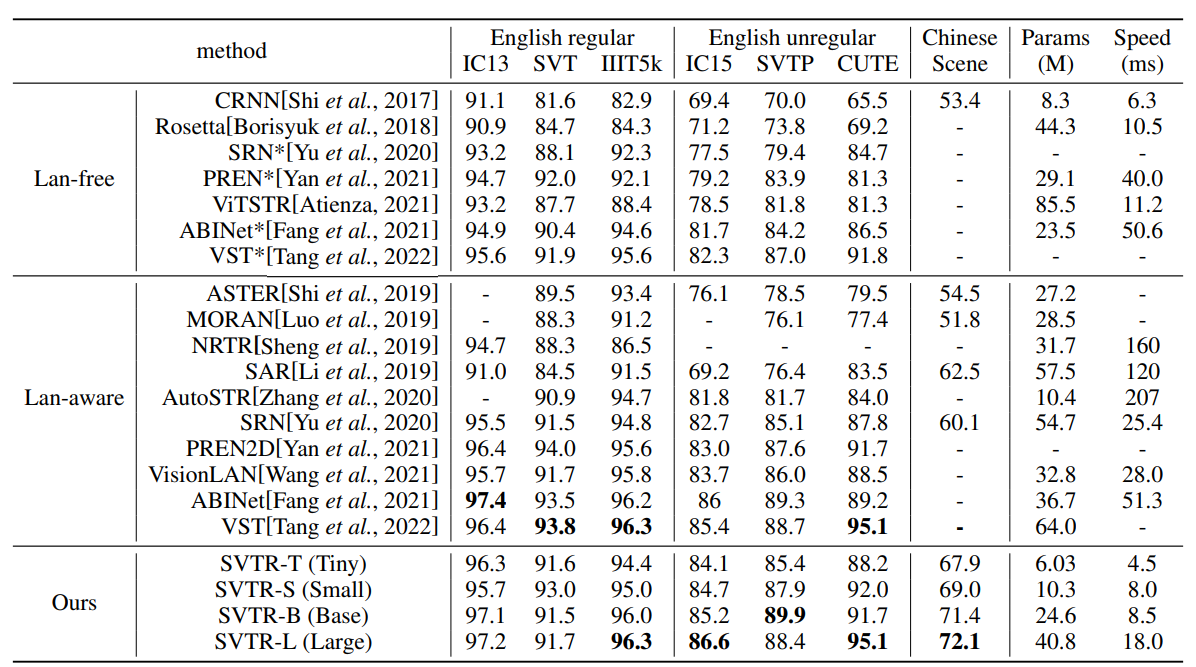SVTR: Scene Text Recognition with a Single Visual Model
constiution: Baidu Inc., Fudan University, China conference: IJCAI 2022 github: https://github.com/PaddlePaddle/PaddleOCR reference: https://arxiv.org/pdf/2205.00159v2.pdf
PP-OCRv3 Introduction: PP-OCRv3, proposed by PaddleOCR team, is further upgraded on the basis of PP-OCRv2. The overall framework of PP-OCRv3 is same as that of PP-OCRv2. The base model of recognition network is replaced from CRNN to SVTR, which is recorded in IJCAI 2022.
There are 9 optimization strategies for text detection and recognition models in PP-OCRv3, which are as follows. In terms of effect, when the speed is comparable, the accuracy of various scenes is greatly improved: - In Chinese scenarios, PP-OCRv3 outperforms PP-OCRv2 by more than 5%. - In English scenarios, PP-OCRv3 outperforms PP-OCRv2 by more than 11%. - In multi-language scenarios, models for more than 80 languages are optimized, the average accuracy is increased by more than 5%.
Abstract
- In this study, we propose a Single Visual model for Scene Text recognition within the patch-wise image tokenization framework, which dispenses with the
sequential modelingentirely. - The method, termed SVTR, firstly decomposes an image text into small patches named character components.
- Global and local mixing blocks are devised to perceive the inter-character and intra-character patterns, leading to a multi-grained character component perception. Thus, characters are recognized by a simple linear prediction.
Figure 1: (a) CNN-RNN based models. (b) Encoder-Decoder models. MHSA and MHA denote multi-head self-attention and multihead attention, respectively. (c) Vision-Language models. (e.g. SRN, ABINet) (d) Our SVTR, which recognizes scene text with a single visual model and enjoys efficient, accurate and cross-lingual versatile.
Method
Overall Architecture

Figure 2: Overall architecture of the proposed SVTR. It is a three-stage height progressively decreased network. In each stage, a series of mixing blocks are carried out and followed by a merging or combining operation. At last, the recognition is conducted by a linear prediction.
Progressive Overlapping Patch Embedding

Figure 3: (a) The linear projection in ViT [Dosovitskiy et al., 2021]. (b) Our progressive overlapping patch embedding.
- There exists two common one-step projections for this purpose, i.e., a 4×4 disjoint linear projection (see Figure 3(a)) and a 7 × 7 convolution with stride 4.
- Alternatively, we implement the patch embedding by using two consecutive 3 × 3 convolutions with stride 2 and batch normalization, as shown in Figure 3(b).
- The scheme, despite increasing the computational cost a little, adds the feature dimension progressively which is in favor of feature fusion.
Mixing Block

Figure 4: Illustration of (a) global mixing and (b) local mixing.
- Since two characters may differ slightly, text recognition heavily relies on features at character component level.
- We argue that text recognition requires two kinds of features:
- The first is local component patterns such as the stroke-like feature. It encodes the morphology feature and correlation between different parts of a character.
- The second is intercharacter dependence such as the correlation between different characters or between text and non-text components.
- Therefore, we devise two mixing blocks to perceive the correlation by using self-attention with different reception fields.
Merging
- It is computational expensive to maintain a constant spatial resolution across stages, which also leads to redundant representation.
- we employ a $3 × 3$ convolution with stride $2$ in the height dimension and $1$ in the width dimension, followed by a layer norm, generating an embedding of size $\frac{h}{2} × w × d_{i}$.
- The merging operation halve the height while keep a constant width. It not only reduce the computational cost, but also build a text-customized hierarchical structure.
Combining and Prediction
- It pools the height dimension to $1$ at first, followed by a fully-connected layer, non-linear activation and dropout.
- By doing this, character components are further compressed to a feature sequence, where each element is represented by a feature of length $D_{3}$.
- Compared to the merging operation, the combining operation can avoid applying convolution to an embedding whose size is very small in one dimension, e.g., with $2$ in height.
Experiments
The Effectiveness of Patch Embedding

Figure 5: Accuracy-parameter (M) and Accuracy-speed (ms) plots of different models on IC15.
Comparison with State-of-the-Art

Table 4: Results on six English and one Chinese benchmarks tested against existing methods, where CRNN and Rosetta are from the reproduction of CombBest [Baek et al., 2019]. Lan means language and * means the language-free version of the corresponding method. The speed is the inference time on one NVIDIA 1080Ti GPU averaged over 3000 English image text.